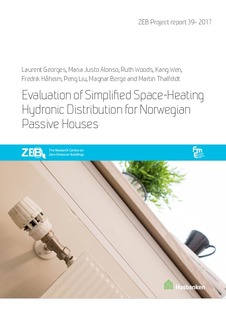| dc.contributor.author | Georges, Laurent | |
| dc.contributor.author | Alonso, Maria Justo | |
| dc.contributor.author | Woods, Ruth | |
| dc.contributor.author | Wen, Kang | |
| dc.contributor.author | Håheim, Fredrik | |
| dc.contributor.author | Liu, Peng | |
| dc.contributor.author | Berge, Magnar | |
| dc.contributor.author | Thalfeldt, Martin | |
| dc.date.accessioned | 2017-10-27T09:19:20Z | |
| dc.date.available | 2017-10-27T09:19:20Z | |
| dc.date.created | 2017-10-26T13:23:16Z | |
| dc.date.issued | 2017 | |
| dc.identifier.isbn | 978-82-536-1558-5 | |
| dc.identifier.uri | http://hdl.handle.net/11250/2462528 | |
| dc.description.abstract | This technical report combines research results from the Norwegian Research Center on Zero Emission Buildings (ZEB) and a competence project about simplified hydronic distribution funded by Husbanken. In the Norwegian definition of the passive house standard (NS3700), the current building code TEK10 or existing concepts of ZEB residential buildings, building envelopes are so-called super-insulated in order to drastically reduce the space-heating needs. Given this high level of insulation, it is theoretically possible to simplify the space-heating distribution inside the building by reducing the number of heat emitters. There is currently a lack of theoretical knowledge about the design of simplified distribution systems and lack of evidence-based feedbacks about their actual performance during real operation. The present work investigates the performance of simplified space-heating distribution in superinsulated residential buildings using one radiator per floor. The case with less than one heat emitter per floor is not considered here. In all investigated cases, the building was equipped with balanced mechanical ventilation with one centralized heat recovery and one set-point temperature for the supply ventilation air (sometimes called one-zone mechanical ventilation). In other words, all the supply ventilation air is preheated at the same temperature, without distinction between rooms. The research methodology is based on field and laboratory measurements, calibrated detailed dynamic simulations (using IDA-ICE) as well as user’s interviews. The main research question was to investigate the real, desired and perceived thermal environment in heated areas (like the living room) and in the rooms without radiators (like bedrooms). In this context, the question of window openings in bedrooms was also addressed. The research also investigated the user behavior, such as the way users operate the heating system in reality. In addition... | nb_NO |
| dc.language.iso | eng | nb_NO |
| dc.publisher | SINTEF akademisk forlag | nb_NO |
| dc.relation.ispartof | ZEB Project report | |
| dc.relation.ispartofseries | ZEB Project report; | |
| dc.subject | Radiator | nb_NO |
| dc.subject | Passivhus | nb_NO |
| dc.subject | Passive house | nb_NO |
| dc.subject | Forenkling | nb_NO |
| dc.subject | Simplification | nb_NO |
| dc.subject | Termisk komfort | nb_NO |
| dc.subject | Thermal comfort | nb_NO |
| dc.title | Evaluation of Simplified Space-Heating Hydronic Distribution for Norwegian Passive Houses | nb_NO |
| dc.type | Research report | nb_NO |
| dc.description.version | publishedVersion | nb_NO |
| dc.source.pagenumber | 118 | nb_NO |
| dc.source.issue | 39 | nb_NO |
| dc.identifier.cristin | 1508021 | |
| dc.relation.project | Norges forskningsråd: 193830 | nb_NO |
| cristin.unitcode | 194,64,25,0 | |
| cristin.unitcode | 194,0,0,0 | |
| cristin.unitcode | 194,61,55,0 | |
| cristin.unitname | Institutt for energi- og prosessteknikk | |
| cristin.unitname | Norges teknisk-naturvitenskapelige universitet | |
| cristin.unitname | Institutt for arkitektur og teknologi | |
| cristin.ispublished | true | |
| cristin.fulltext | original | |
